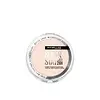Maybelline Superstay 24H Hybrid Powder Foundation Versus NYX Cosmetics Can't Stop Won't Stop Full Coverage Foundation
What's inside
What's inside
 Key Ingredients
Key Ingredients

 Benefits
Benefits

 Concerns
Concerns

 Ingredients Side-by-side
Ingredients Side-by-side

Talc
AbrasiveZinc Stearate
Cosmetic ColorantDimethicone
EmollientSilica
AbrasiveZea Mays Starch
AbsorbentCaprylic/Capric Triglyceride
MaskingDimethicone/Vinyl Dimethicone Crosspolymer
Skin ConditioningCaprylyl Glycol
EmollientTriethoxycaprylylsilane
Ethylhexylglycerin
Skin ConditioningPotassium Sorbate
PreservativeIsoceteth-10
EmulsifyingAlaria Esculenta Extract
Skin ProtectingTocopherol
AntioxidantCI 77891
Cosmetic ColorantCI 77491
Cosmetic ColorantCI 77492
Cosmetic ColorantCI 77499
Cosmetic ColorantCI 19140
Cosmetic ColorantMica
Cosmetic ColorantCI 15850
Cosmetic ColorantCI 77742
Cosmetic ColorantCI 77007
Cosmetic ColorantTalc, Zinc Stearate, Dimethicone, Silica, Zea Mays Starch, Caprylic/Capric Triglyceride, Dimethicone/Vinyl Dimethicone Crosspolymer, Caprylyl Glycol, Triethoxycaprylylsilane, Ethylhexylglycerin, Potassium Sorbate, Isoceteth-10, Alaria Esculenta Extract, Tocopherol, CI 77891, CI 77491, CI 77492, CI 77499, CI 19140, Mica, CI 15850, CI 77742, CI 77007
Water
Skin ConditioningDimethicone
EmollientIsododecane
EmollientNylon-12
Acrylates/Polytrimethylsiloxymethacrylate Copolymer
Skin ConditioningSilica
AbrasiveButylene Glycol
HumectantPEG-10 Dimethicone
Skin ConditioningIsohexadecane
EmollientIsononyl Isononanoate
EmollientPentylene Glycol
Skin ConditioningSynthetic Fluorphlogopite
Bis-PEG/PPG-14/14 Dimethicone
EmollientMagnesium Sulfate
Phenoxyethanol
PreservativeCaprylyl Glycol
EmollientAcrylonitrile/Methyl Methacrylate/Vinylidene Chloride Copolymer
Disodium Stearoyl Glutamate
CleansingDisteardimonium Hectorite
StabilisingCalcium Gluconate
HumectantPerlite
AbsorbentMagnesium Gluconate
Skin ConditioningTocopherol
AntioxidantAluminum Hydroxide
EmollientIsobutane
CI 77891
Cosmetic ColorantIron Oxides
Water, Dimethicone, Isododecane, Nylon-12, Acrylates/Polytrimethylsiloxymethacrylate Copolymer, Silica, Butylene Glycol, PEG-10 Dimethicone, Isohexadecane, Isononyl Isononanoate, Pentylene Glycol, Synthetic Fluorphlogopite, Bis-PEG/PPG-14/14 Dimethicone, Magnesium Sulfate, Phenoxyethanol, Caprylyl Glycol, Acrylonitrile/Methyl Methacrylate/Vinylidene Chloride Copolymer, Disodium Stearoyl Glutamate, Disteardimonium Hectorite, Calcium Gluconate, Perlite, Magnesium Gluconate, Tocopherol, Aluminum Hydroxide, Isobutane, CI 77891, Iron Oxides
 Reviews
Reviews

Ingredients Explained
These ingredients are found in both products.
Ingredients higher up in an ingredient list are typically present in a larger amount.
Caprylyl Glycol is a humectant and emollient, meaning it attracts and preserves moisture.
It is a common ingredient in many products, especially those designed to hydrate skin. The primary benefits are retaining moisture, skin softening, and promoting a healthy skin barrier.
Though Caprylyl Glycol is an alcohol derived from fatty acids, it is not the kind that can dry out skin.
This ingredient is also used as a preservative to extend the life of products. It has slight antimicrobial properties.
Learn more about Caprylyl GlycolCi 77891 is a white pigment from Titanium dioxide. It is naturally found in minerals such as rutile and ilmenite.
It's main function is to add a white color to cosmetics. It can also be mixed with other colors to create different shades.
Ci 77891 is commonly found in sunscreens due to its ability to block UV rays.
Learn more about CI 77891Dimethicone is a type of synthetic silicone created from natural materials such as quartz.
What it does:
Dimethicone comes in different viscosities:
Depending on the viscosity, dimethicone has different properties.
Ingredients lists don't always show which type is used, so we recommend reaching out to the brand if you have questions about the viscosity.
This ingredient is unlikely to cause irritation because it does not get absorbed into skin. However, people with silicone allergies should be careful about using this ingredient.
Note: Dimethicone may contribute to pilling. This is because it is not oil or water soluble, so pilling may occur when layered with products. When mixed with heavy oils in a formula, the outcome is also quite greasy.
Learn more about DimethiconeSilica, also known as silicon dioxide, is a naturally occurring mineral. It is used as a fine, spherical, and porous powder in cosmetics.
Though it has exfoliant properties, the function of silica varies depending on the product.
The unique structure of silica enhances the spreadability and adds smoothness, making it a great texture enhancer.
It is also used as an active carrier, emulsifier, and mattifier due to its ability to absorb excess oil.
In some products, tiny microneedles called spicules are made from silica or hydrolyzed sponge. When you rub them in, they lightly polish away dead skin layers and enhance the penetration of active ingredients.
Learn more about SilicaTocopherol (also known as Vitamin E) is a common antioxidant used to help protect the skin from free-radicals and strengthen the skin barrier. It's also fat soluble - this means our skin is great at absorbing it.
Vitamin E also helps keep your natural skin lipids healthy. Your lipid skin barrier naturally consists of lipids, ceramides, and fatty acids. Vitamin E offers extra protection for your skin’s lipid barrier, keeping your skin healthy and nourished.
Another benefit is a bit of UV protection. Vitamin E helps reduce the damage caused by UVB rays. (It should not replace your sunscreen). Combining it with Vitamin C can decrease sunburned cells and hyperpigmentation after UV exposure.
You might have noticed Vitamin E + C often paired together. This is because it is great at stabilizing Vitamin C. Using the two together helps increase the effectiveness of both ingredients.
There are often claims that Vitamin E can reduce/prevent scarring, but these claims haven't been confirmed by scientific research.
Learn more about Tocopherol